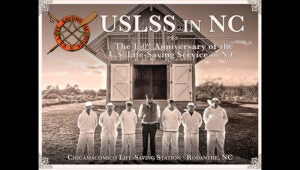USLSS in NC: The Wright effect
Published 1:20 pm Wednesday, October 9, 2024

- The Moccasin. Courtesy Chicamacomico LifeSaving Station
|
Getting your Trinity Audio player ready...
|
By Jen Carlson
On December 3, 1903, a surfman from the Currituck Beach LifeSaving Station (formerly known as Jones Hill) spotted a vessel stranded about 500 yards northeast of the station. Keeper W.F. Parker immediately reported the discovery by wire to the department before leading the crew out to the beach. The Lyle Gun was quickly set in place and the first line of communication was sent to the vessel.
Strong winds and rough seas beat against the vessel but there were no signs of life on board. After a short wait to see if anyone would start hauling the lines, the crew retreated back to the station to get out of the weather.
Nearly 24 hours after her discovery, just after midnight, the storm abated enough to allow the crew to launch the surf boat and finally reach the vessel’s side. A thorough search of the vessel proved it was empty and the crew once again returned to shore.
While the involvement of the CBLSS crew ended with the discovery that the vessel was empty, her story would continue in a unique way. The vessel that stranded near the station turned out to be a US Navy submarine named The Moccasin. While it’s not clear how the submarine ended up on the beach that early morning, the Navy wanted the vessel monitored until it could be retrieved.
Future Coast Guardsman A.W. Drinkwater was working as a repairman for the US Weather Bureau and was tasked with monitoring The Moccasin as the Weather Bureau had a reliable telegraph line linked to Norfolk, Virginia.
Two weeks after she stranded, the local commercial telegraph operator asked Drinkwater to send a telegram because he couldn’t reach the mainland. The message sent was from two brothers to their family back home and would change the world: “Success four flights Thursday morning all against twenty one mile wind started from level with engine power alone average speed through air thirty one miles longest 57 seconds inform press home Christmas.-Orevelle”
All in a Day’s Work
Sometimes it’s all about ingenuity: Just before sunrise on February 26, 1886, the lookout from the Little Kinnakeet LifeSaving Station spotted a schooner near the shoal line about three miles southwest of the station. Soon afterwards, the schooner raised a signal asking for a pilot.
The strong headwinds and rain prevented the crew from being able to row the surf boat so instead, they obtained a large canoe and headed out into the storm. The vessel turned out to be the John Young with a five man crew onboard. She had gotten off course and the shoals were making it difficult for her to be navigated.
The surfmen boarded the schooner to reef the sails and helped heave up the anchors. The crews then worked together to get her into deeper water where the captain was told the best channels to follow before the surfmen departed and the schooner continued her voyage.
For more stories like these, visit the Chicamacomico LifeSaving Station where history is alive.
We hope you will join us October 11-13, 2024 in celebration as we recognize the #LegacyofLifeSaving and the lasting impact of these often-unsung heroes. Go to chicamacomico.org for details of the events.
READ MORE IN THIS SERIES HERE:
SUBSCRIBE TO THE COASTLAND TIMES TODAY!







